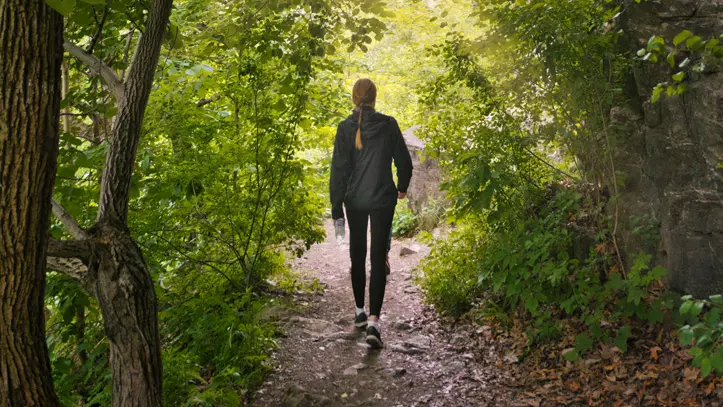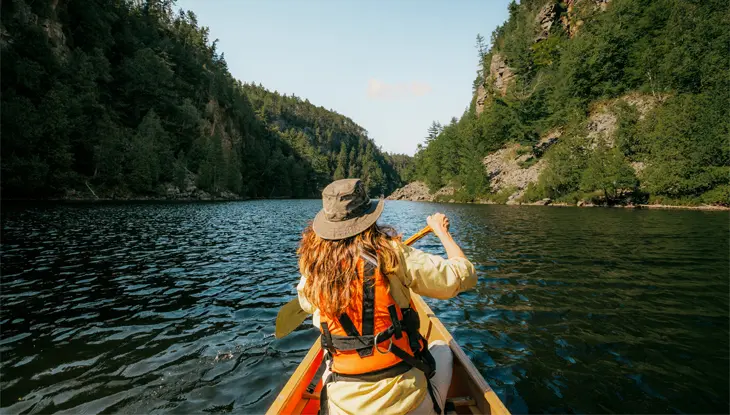Take a wellness journey into Ontario’s parks, trails and forests

Niagara Glen | Niagara Falls Tourism
Finding wellness in the forest is not a new concept. The ancient Japanese practice of “Shinrin-yoku” translates to “forest bathing,” “Friluftsliv” is the Nordic tradition of embracing outdoor life, and “Waldeinsamkeit” is the German term for experiencing solitude in the forest and connecting with nature.
From summer hiking boots to winter snowshoes, each season transforms Ontario’s forests and woodland trails with changing climate, scenery and wildlife.
Capture magical moments on a birdwatching expedition, delight in an evening of winter stargazing or explore blooming gardens and horticulture attractions. Lace up a pair of skates and enjoy skating under the stars on a skate trail.
Ontario Provincial Parks

The government of Ontario manages over 330 provincial parks that span approximately ten million hectares of land and water. These conservation reserves balance recreation, education and preservation with sustainable tourism.
Operating parks offer visitor services, facilities and experiences, including information centres, camping and roofed accommodations, washrooms and showers and learning and discovery programs.
Seasonal activities in Ontario Parks
There’s plenty to do year-round at Ontario Parks.
Explore extensive networks of land and water trails. Enjoy hiking, paddling, swimming and wildlife viewing. Winter activities include snowshoeing, cross-country skiing and, in some parks, skating on ice trails and winter camping.
Just south of Port Elgin on the shores of Lake Huron, MacGregor Point is the first provincial park to offer a designated forest therapy trail.
Find an Ontario park near you on a map or search by activities, facilities and rentals. Fees and reservation requirements vary depending on what activities you choose. Make reservations in advance whenever possible.
Restorative effects of Ontario Parks
Research in Ontario Parks demonstrates the restorative effects of spending time in nature. Visitors experienced mental and physical benefits from hiking, paddling and relaxing on the beach. Positive results were reported for short visits as well as longer excursions.
For these reasons, the Healthy Parks Healthy People program offers an annual free day of access to Ontario Parks in July 2025, among other incentives, to encourage us to connect with nature.
National parks

Parks Canada represents almost 50 protected natural areas, parks and reserves across the country, including these six national parks in Ontario.
Bruce Peninsula National Park
Bruce Peninsula National Park is famous for rocky vistas over clear, aqua waters and incredible outdoor experiences such as wildlife viewing and hiking.
Point Pelee National Park
Although Point Pelee National Park is Canada’s second-smallest national park, it is also the most diverse. Operating year-round, the park is a key stop during annual bird and butterfly migrations. In fact, it’s one of the best bird watching destinations in Canada.
Just as spending time under the sun invigorates, spending time under the moon and stars enchants. Witness the splendour of the night sky from West Beach, a prime spot to take in the constellations and Dark Sky Night events.
Rouge National Urban Park
Located just east of downtown Toronto, Rouge National Urban Park is Ontario’s largest urban area. Explore rich natural and cultural ecosystems along hiking trails. The park operates year-round, is open daily and entry is free.
Georgian Bay Islands National Park
Seasonally, Georgian Bay Islands National Park lures paddlers to explore Lake Huron. The park also offers self-guided tours to explore the cultural landscape of Beausoleil Island.
Pukaskwa National Park
Located on the biodiverse shore of Lake Superior, Pukaskwa National Park is Ontario’s only park with a wilderness designation. Hike along rugged coastal trails, follow the shoreline on the two-kilometre Beach Trail to beaches or take in breathtaking views from the White River Suspension Bridge.
Thousand Islands National Park
Thousand Islands National Park features over 1000 islands sprinkled throughout the St. Lawrence River.
Download a self-guided audio tour and explore popular hiking trails at your own pace.
Learn about various ways to visit the Islands and check out the calendar of family-friendly education programs available. Overnight accommodations includes camping and oTENTik structures.
Conservation areas

Conservation Ontario represents 36 Conservation Authorities across Ontario, which own and manage over 500 conservation areas, more than 300 of which are open to the public.
Like Ontario’s parks, these conservation areas are spread across the province and vary dramatically in landscape, with waterways, wetlands and waterfalls to discover and forests, marshes, dunes and beaches to wander through.
Several conservation areas feature free entry, and even more operate year-round with various activities available, including snowshoeing, ice skating, skiing, hiking and nature viewing.
Between May and October, take part in Step into Nature: Healthy Hikes at Ontario Conservation Areas, an annual outdoor wellness challenge.
Find a conservation area near you.
Ontario’s Parks Commissions
Two government crown agencies manage and conserve parklands, recreation sites and heritage sites in the Niagara region and along the shores of the St. Lawrence River.
St. Lawrence Parks Commission
The St. Lawrence Parks Commission manages the series of parks and various attractions along the 280-kilometre stretch between Kingston and Cornwall.
Cyclists can enjoy scenic off-road cycling along Long Sault Parkway, which connects to the Great Lakes Waterfront Trail. Self-guided hiking trails in Upper Canada Migratory Bird Sanctuary offer abundant bird watching.
Niagara Parks Commission
Famously described as the “prettiest Sunday drive” by Winston Churchill, the 56-kilometre route between Niagara-on-the-Lake and Fort Erie is maintained by the Niagara Parks Commission and features varied natural landscapes with hiking and cycling trails and gardens.
Wellness and safety in nature go hand in hand. Niagara Parks provides helpful tips and reminders on trail etiquette and safety.
Private and semi-private parks

Several nature parks and wilderness areas in Ontario are privately owned or co-managed.
Hiawatha Highlands
Hiawatha Highlands operates in conjunction with Sault Ste. Marie Regional Conservation Authority, the Kinsman Club, the Ministry of Natural Resources and Forestry and other landowners. The cross-country ski and snowshoe trails are groomed regularly, and daily passes, seasonal memberships and rentals are available.
Limberlost Forest
Just a 25-minute drive east of Huntsville, Limberlost Forest is a privately owned wilderness and wildlife reserve with maintained hiking and snowshoeing trails that loop through mixed forests and lakes. The trails are open to the public year-round for free.
Haliburton Forest & Wild Life Reserve
Located next to Algonquin Park in the Haliburton Highlands, this reserve is a privately owned recreational wonderland where outdoor enthusiasts and nature lovers can enjoy outdoor activities such as forest canopy tours, camping and astronomy.
Robert L. Bowles Nature Centre
Explore, learn about and reconnect with nature through various year-round workshops at the Robert L. Bowles Nature Centre, located in Ramara, just north of Lake Simcoe. Workshops include mammal tracking, nature immersion and music around a campfire.
Point Grondine Park
Point Grondine Park is owned and operated by the Wiikwemkoong Unceded Territory. Located east of Killarney, the park features designated hiking trails, scenic paddling routes, camping and other outdoor adventures.
Park trails often provide information about the local flora and fauna. For example, the self-guided A-Mik-Zii-Bi Interpretive Trail at Point Grondine Park is a fascinating three-kilometre loop featuring educational signage detailing Indigenous medicinal knowledge about various plants along the way.
Ontario Trails of Distinction
A selection of iconic trails in Ontario have been celebrated for their accessibility, connectedness and versatility.
These five Ontario Trails of Distinction are worth leaving the road to explore. They present endless opportunities to experience wellness in nature, from an invigorating afternoon stroll to multi-day backcountry adventures.
Bruce Trail
Hike unspoiled nature trails past scenic cliffs and shorelines along the 900-kilometre trail, the oldest in Ontario. It snakes between the Niagara Peninsula and the Bruce Peninsula, a UNESCO World Biosphere Reserve.
Voyageur Trail
Inspired by the early voyageur fur traders’ routes, the epic trail extends almost 600 kilometres between Sudbury and Thunder Bay. It offers hiking opportunities on Manitoulin Island and along the shores of Lake Huron and Lake Superior.
TransCanada Trail
This multi-use, coast-to-coast trail across Canada is the world’s longest network of recreational trails. Some parts of the trail merge with the National Trail. The Ontario portions reach from the Manitoba border to North Bay, down towards Hamilton and from Windsor to Ottawa.
Great Lakes Waterfront Trail
Following over 3,000 kilometres along the shores of Lake Ontario, Lake Erie, Georgian Bay, Lake Huron, Lake St. Clair and the Niagara, Detroit and St. Lawrence Rivers, the multi-use, signposted Great Lakes Waterfront Trail connects people to over 400 parks and natural areas including wetlands, forests and beaches.
Greenbelt Route
Ontario’s Greenbelt covers two million acres of protected forest, rivers, farms, wetlands, watersheds and countryside that extend from Niagara River to the Oak Ridges Moraine, near Rice Lake. Ten thousand kilometres of trail and road make up the Greenbelt Route and include part of the Bruce Trail, Oak Ridges Moraine Trail and Ganaraska Trails.
Ontario Trails
Whether hiking, biking, paddling, snowshoeing, skating or cross-country skiing, find the perfect trail for your next outdoor excursion with Ontario Trails.
Ontario Trails Council is a charity that promotes the development and preservation of recreational trails and activities. It is also an unbeatable resource, providing in-depth trail information, maps and trail education.
Hiking events
Celebrate the great outdoors with fellow hikers and nature lovers.
First Day Hike
The annual First Day Hike at Ontario Parks is an excellent way to kick-start the new year. As part of the Healthy Parks Healthy People initiative, visitors are encouraged to take a self-guided walk or join a guided hike in participating parks.
Hike Haliburton Festival
Hike Haliburton Festival in early February features guided and self-guided hikes and nature-based experiences during the winter version of the event. The fall event takes place on the third weekend in September.
Trails Fest
Trails Fest is an annual two-day summer celebration of the beautiful and biodiverse Frontenac Arch Biosphere Region. Enjoy a weekend of free guided hikes.
Related content
Last updated: July 18, 2025


